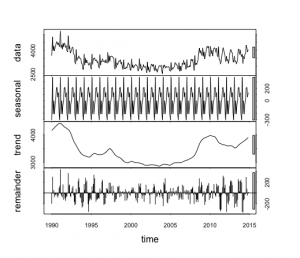Students–and the rest of the world–often wonder why academics are awarded sabbatical leaves when no one else seems to have this benefit. Well, the idea of a sabbatical is to give a faculty member time away from other responsibilities, including teaching, so they can advance their professional development. Sabbaticals are thus typically periods of focused research. In this post, I share the example of my 2019 sabbatical in Paris.
I spent this sabbatical at the Centre Population et Développement located at the Université Paris Descartes. There, I worked with Christophe Guilmoto (demographer) and Sara Tafuro (economist), scholars researching “missing women,” shortfalls in females relative to males resulting from sex-selective abortions, female infanticide and intentional neglect.
Christophe and Sara’s research in the former Soviet state of Georgia resulted in an interesting side project that became the focus of my sabbatical research. Georgia, like all former Soviet states, experienced a dramatic fall in fertility (illustrated in the black, dashed line in the graph below–click on it for a larger, clearer image) in the chaos that followed the dissolution of the Soviet Union. The economic uncertainty and social unrest of this period made child bearing too expensive and too risky for many of the people of Georgia.

The fertility rate began to recover after Mikheil Saakashvili’s election (2004) brought relative stability to the country, but fertility was still below the replacement rate and not sufficient to halt the decline in population that began in the 1990s, a problem exacerbated by outmigration, particularly of women. The various ethnic groups in Georgia follow patrilineal and patrilocal cultural norms and typically stop at two children if one of them is a boy (the connection to the missing women work) which, alone, could result in below-replacement fertility.
In an attempt to reverse the population decline, in late 2007, the Patriarch of the Georgian Orthodox Church offered to personally baptize every third child born to married couples. The project on which I am working is an assessment of whether this proclamation changed fertility behavior and, if so, whether the change represented a new trend or a time shift of an existing trend. This question is interesting in itself, but also fits into a larger debate about whether moral suasion can change demographic behavior or if changes in material circumstances are required. The question is well suited to my research area of impact evaluation because in Georgia there is a natural separation into treatment (ethnic Georgian Orthodox) and control groups (ethnic Georgian muslims, ethnic Azeri Muslims and ethnic Armenian non-orthodox Christians who would not be responsive to the Orthodox Patriarch’s exhortations).
To be able to compare trends in the different groups, it is first necessary to identify the trends in each, and my summer work focused on this. Fertility data is very “noisy” and has strong seasonality. The figure above was made with data that had been “smoothed” through various means. The normalized raw birth data for the different groups actually look like this:
I separated each series into trend, seasonality and random variation (using the R package “stl” for all you econometrics students) and then applied a variety of moving average approaches to further smooth the data.
We then looked for “breakpoints” in the trends using piecewise/segmented regression analysis.The best resulting figures (Christophe’s) are these below, suggesting a dramatic difference between the treatment and control groups around the time of the patriarch’s proclamation.
The next step will be to undertake a difference-in-differences (DID) analysis to determine if this observation is statistically supported. This is the same analytical method that Lea and I teach in our econometrics courses, although I also intend to employ DID with multiple control groups.
I will report back when I have these results!




So interesting! Thanks for sharing this, Matt. I look forward to reading the results of your analysis.
Thanks for the support, Lisa!